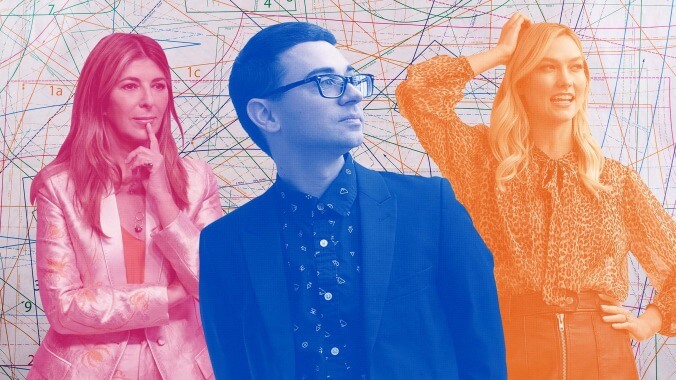Obviously, no one wanted Weinstein to profit further from the series or possibly use it to wield undue influence. Yet when Lantern Entertainment, the company that’d acquired the Weinstein Co. assets in May 2018, shared plans to welcome Project Runway back to the Bravo lineup, it was a heartening announcement, even if the show had begun to morph into the reality-competition-series equivalent of a DKNY dress: reliable, but hardly remarkable. But when Project Runway made its last stand at Lifetime in 2017 with season 16, it introduced a piquant development that finally ushered in some body diversity. The inclusion of models with different body types and sizes (ranging from 0-22) made for some of the best runway in years, with many of those highlights coming from Liris Crosse, the “Naomi Campbell of plus-size,” who offered thoughtful critiques along with her glorious strut.
Project Runway’s overhaul ahead of its 17th season, which is hosted by social media-savvy model and entrepreneur Karlie Kloss, has put it back in the running for best in reality shows. But that success hinges on an old standby. One of the show’s greatest strengths has been its commitment to highlighting and cultivating talent. There will always be some designers who are stronger than others, but Project Runway doesn’t revel in their disasters—you won’t find a compilation like this in its inventory. While that approach has occasionally made the show look almost staid when compared to something like Survivor, it also positioned Project Runway as a forebear to the new line of good-hearted competition shows like The Great British Baking Show and Making It. Project Runway has always reflected the mercurial nature of the fashion industry, from eliminations down to its catchphrase, made famous by Klum, that observed how a designer could be in one day and out the next. In season 17, the show is no less resolute in its decisions, but there’s also a renewed investment in making sure everyone is putting their best Louboutin forward.
Everyone from the host to the judges—a returning Garcia, designer Brandon Maxwell, and former Teen Vogue editor-in-chief Elaine Welteroth—is incredibly invested in the new crop of designers, whose numbers have been winnowed down from 16 to six since March of this year. Just last week, Welteroth, who was lauded for fusing politics and fashion in her tenure at Teen Vogue, joined the remaining designers in the workroom to guide them through a challenge that required them to put the activist causes closest to their hearts on their models’ sleeves (and bodices and skirts). But the figure who best demonstrates the potential of this reinvigorated focus is Christian Siriano, winner of Project Runway season four and the show’s biggest success story to date.
One of the hallmarks of reality competition series, from The Voice to RuPaul’s Drag Race, is evolution—a contestant can botch their first impression as long as they learn from it and grow. Complacency and stagnancy, on the other hand, are never a good look. Siriano was one of the strongest contenders in his season, standing out from the rest of the pack for all the right and wrong reasons: He picked up three challenge wins (the exact number that season 17 frontrunner Hester Sunshine currently has), but also became notorious for a transphobic slur he used as a catchphrase. Shortly after nabbing victory at New York Fashion Week in 2008, Siriano apologized for using the slur and vowed to do better, which he has in part by making sure his own eponymous fashion line is inclusive, as well as heeding the call of celebs like Leslie Jones, who expressed dismay over the underwhelming response from fashion houses when she needed a dress for the Ghostbusters premiere. He’s partnered with Lane Bryant, Payless, TJ Maxx, and the Home Shopping Network because, as he told Fast Company earlier this year, he envisions people of all sizes and incomes when he thinks of who his customer is.
Siriano has sacrificed none of his vision or verve in doing so—for proof, look no further than the jaw-dropping looks he crafted for Met Gala attendees like Janelle Monáe and Ryan Murphy. Siriano continues to deliver must-haves on the red carpet and in ready-to-wear collections, so his reputation and bottom line have never looked better. On any other season of Project Runway, Siriano would have been invited back to guest judge, or maybe pose a challenge to designers like season 17’s Bishme Cromartie, who has fused his Baltimore civic pride with polished yet exuberant looks. His success would have served as temporary inspiration for the contestants, even as it eludes most winners of the show. But Bravo wisely chose to bring Siriano on as a mentor for the new batch of designers because he knows this competition and business inside out.
Gunn’s contributions can’t be downplayed—he gave designers sound, if often vague, advice while giving the rest of the world “make it work.” Although he hasn’t crafted a new catchphrase yet, Siriano’s guidance has proven more helpful because he’s toiled in this workroom, worrying about a seam or the cohesiveness of a design under these exact conditions. Like Gunn, he espouses the importance of time management, but because Siriano knows just what you can accomplish under these constraints, his suggestions feel more relevant. Siriano is careful not to overstep his bounds either—he often puts out a prompt or a question and waits for a response. He asks a lot of questions of the designers, including Cromartie, who just last week was over-editing himself in response to criticism about “doing too much” with his looks. But Siriano, who recalled how brightly Cromartie had shone the last time he was asked to bring some of his hometown to his art, gently urged him to consider whether his cause-inspired creation was really representative of the Baltimore kids he was encouraging to “blossom.” (Spoiler: Cromartie won the challenge after revising his look.)
Siriano’s presence has done more than just keep the designers on task and from questioning themselves—it’s given Project Runway some much-needed relevance. He knows the importance of having body diversity among the models, which he cited in an op-ed for NBCNews as one of the elements necessary to reflect “what’s happening in our world right now.” In the same piece, he extolled the virtues of the absolutely stunning Mimi Tao, who, in addition to being the most-sought-after model on the show, is the first trans model in Project Runway’s history. And while Michael Kors, and Isaac Mizrahi are all household names, they just don’t feel as relevant or exciting as Siriano, who helped bring us Billy Porter in a gown at the Oscars. Siriano isn’t doing it alone, of course: Kloss is a serviceable host, though she’s still finding her footing. Garcia is as laser-focused (and biting) in her critiques as ever, though she’s getting some competition from Maxwell, who doesn’t withhold his analysis while the models are on the runway, and Welteroth, who regularly encourages the designers to put it all on the line while also dragging them for their trailing, unfinished hemlines. But Siriano’s glow-up from enfant terrible to breakout designer to tried-and-tested guide is as compelling an arc as any that has unfolded on screen. It’s also a great metric for success because it takes into account everything from his aesthetic to his ethos, as well as his profit margins.
Reality TV has seen a preponderance of competition shows across industries, from interior design to home renovations and even the ability to find the treasure in other people’s trash. But what makes Project Runway a cut above the rest is the focus on elevating people, that is, the designers as well as their looks. And in season 17, no one’s done that more than Christian Siriano.


